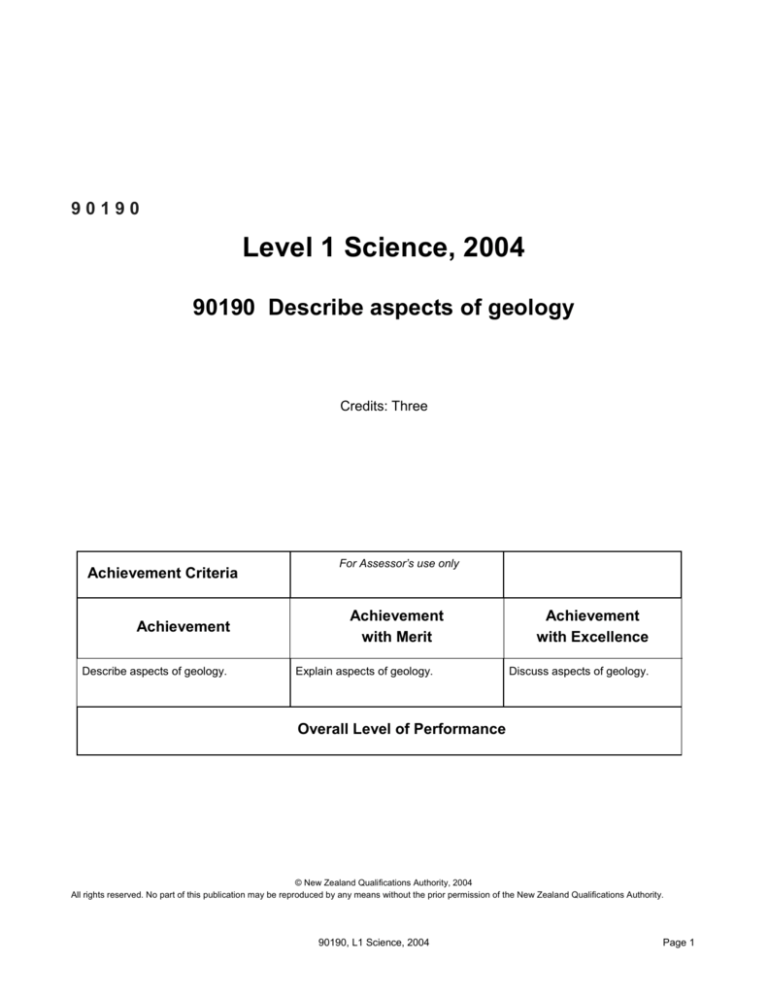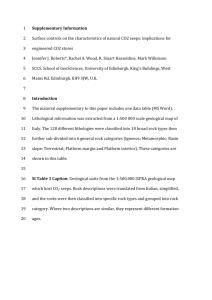
90190
Level 1 Science, 2004
90190 Describe aspects of geology
Credits: Three
Achievement Criteria
Achievement
Describe aspects of geology.
For Assessor’s use only
Achievement
with Merit
Explain aspects of geology.
Achievement
with Excellence
Discuss aspects of geology.
Overall Level of Performance
© New Zealand Qualifications Authority, 2004
All rights reserved. No part of this publication may be reproduced by any means without the prior permission of the New Zealand Qualifications Authority.
90190, L1 Science, 2004
Page 1
You are advised to spend 30 minutes answering the questions in this booklet.
QUESTION ONE
(a)
Rocks are classified as igneous, metamorphic or sedimentary, based on characteristic features
caused by the formation of the rock. Classify each of the rocks described below as igneous,
metamorphic or sedimentary. Each class may be used more than once.
Rock description
(b)
Rock class
(i) A black glassy rock.
(i)
(ii) A flaky rock showing compacted layers of
particles cemented together.
(ii)
(iii) A pale bubbly rock that is rich in silica.
(iii)
(iv) A dark rock with layers of distinct mineral
crystals.
(iv)
Basalt and granite are both igneous rocks but they are formed differently and have different
sized crystals.
(i)
Describe how the crystal size differs between the igneous rocks, basalt and granite.
(ii)
Explain how the formation of granite and basalt results in the different crystal sizes that
you have described in (i) above.
90190, L1 Science, 2004
Page 2
QUESTION TWO
The following is an incomplete diagram of The Rock Cycle.
(a)
State the geological processes that occur at arrows A, B, C and D. Choose from this list:
erosion, melting, metamorphism, solidifying. Each process may be used only once.
A
B
C
D
(b)
Explain how an igneous rock such as granite is changed into a sedimentary rock such as a
conglomerate.
(c)
What rock class does marble belong to?
(d)
Discuss all of the geological processes that lead to the formation of marble.
90190, L1 Science, 2004
Page 3
QUESTION THREE
The following diagram shows the fossils found in the rock layers in three cliff faces, X, Y and Z. These
cliff faces are found in three different localities and separated by many kilometres.
Cliff X
Cliff Y
Cliff Z
No fossils
No fossils
Ammonite
No fossils
Snail
Coral
Trilobite
Clam
No fossils
(a)
Gastropod
Ammonite
Clam
List the fossils in the correct age sequence from oldest to youngest.
Oldest 1
2
3
4
5
6
Youngest
(b)
Give a geological reason why no fossils are found in the layer above the clams in Cliff Y.
90190, L1 Science, 2004
Page 4
QUESTION FOUR
The diagram below shows a stratigraphic column. The layers are the correct way up.
(a)
Name the oldest rock layer.
(b)
Give a reason for identifying this rock layer as the oldest.
(c)
Write a geological history that discusses the processes and order of events that could have
formed the pattern of rock strata as shown in the diagram on page 6.
The following key words may help you.
Sediment
Deposition
Plate tectonics
Sea level
90190, L1 Science, 2004
Fossils
Climate
Rock formation
Page 5







